Some people are turned off by the idea of playing an artist signature model guitar. Their logic usually follows that because there are so many amazing instruments on the market today with so many ways to mod and customize, why would anyone bother playing someone else's guitar?
But this sentiment overlooks the underlying appeal of the great signature models out there. Many artist guitars include innovations and special features that their standard equivalents lack. Others offer a totally unique concept or design which, in turn, spawns its own lineage of variations and special editions. Just look at the Les Paul.
These instruments often draw a cult following of players and collectors, with a micro–market built around the twists and turns of their production history. Today, we're going to investigate the stories behind and markets surrounding five of the most popular and recognizable signature models ever made. We'll explore what makes each unique and what you should consider when thinking about picking one up for yourself.
Fender Stevie Ray Vaughan (SRV) Signature Stratocaster
Perhaps the most famous and simultaneously underrated artist guitar to come out in the last 30 years is the Fender SRV Signature Stratocaster. Originally conceived as far back as 1988 (and prototyped with Stevie’s input), the Stevie Ray Vaughan Strat was based on Stevie’s vintage "Number One" Stratocaster and debuted at the January 1992 NAMM show. With its fat, asymmetrical neck, brand new Custom Shop Texas Specials, and gold reverse tremolo, there was simply no Strat like it at the time.
The tragic circumstances surrounding the model’s origin add to its intrigue. Stevie's untimely death delayed the guitar's distribution, stalling production until Fender got Jimmie Vaughan’s approval to market and release the design. This gap creates some murkiness with the serial numbers and dating of the early specimens.
The earliest SRV models are the most revered, with some carrying Brazilian rosewood fingerboards atop more C–shaped necks, similar to those found on early–'80s Fullerton reissue Fenders.
Subsequent SRV fingerboards were made from Pau Ferro. Outside of the quirks of the initial run, little has changed about the guitar’s specs and presentation over the years.
While the SRV model is an unequivocally excellent Stratocaster, some players are deterred by the presence of Stevie's initials on the pickguard. Keep in mind, though, that pickguards are the easiest thing to swap out on a guitar, and there's a galaxy of suitable replacements for sale on Reverb at any given time.
The burst on these models is absolutely stunning and will always look classy when paired with a standard white or black guard. In fact, the now discontinued but generally respected John Mayer Stratocaster was based on Mayer’s own '96 SRV Strat with a swapped pickguard.
Today, Stevie Strats remain readily available and affordable. You can find one in great condition anywhere from $900 to $1,400, while the rare Brazilian rosewood models from the early '90s usually sell in the $2,000 range.
There have also been occasional Fender Custom Shop spins on the SRV format. They tend vary a bit in price depending on the specific build, but will usually sell for at least several thousand dollars. One limited run of 100 guitars built by Fender Master Builder John Cruz are now being listed for more than $50k.
Fender Eric Clapton Signature Stratocaster
The Eric Clapton Signature is probably the second most recognizable Fender artist Strat behind the SRV. The Clapton Strat was the second signature guitar that Fender released, with origins that date back to the end of the Dan Smith–era of the early '80s. Like a number of early artist models, it took a few years before the guitar finally hit the market in 1988.
Sporting a now famous soft V profile on a one–piece maple neck (there were 100 early examples with rosewood boards), first generation Clapton Strats were also notable for their Lace Gold Sensor pickups with a TBX–tone control and a MDX mid–boost circuit that allowed for 25db of boost.
With Clapton's input, the design was envisioned as a 6–stringed Swiss army knife. The MDX and Lace Sensor combo was meant to achieve all of Clapton’s noted tones, from the fattest Gibsons to the thinnest Fenders.
Players reacted positively to the guitars at the time of their release, and die–hard collectors of the earliest models still exist today. But some players were turned off by the Lace Sensors, and ultimately, Fender switched to Noiseless pickups for both the Clapton model and the related Jeff Beck model in 2001.
The Noiseless Clapton Strats tend to be less heralded by collectors, but from a player’s perspective, they get closer to nailing the quintessential Fender tones with the distinct feel of a Clapton V neck.
Like the SRV Strat, there have been a number of Custom Shop takes on the Clapton Strat, including more regular entries and several limited editions. Custom Shop Clapton Strats built by Fender Master Builders will usually sell in the $4,000 to $6,000 range.
The standard edition Clapton models typically sell for anywhere from $800 to $1,300 depending on condition, with early examples in Torino Red or Candy Green commanding a small premium.
Of note to anyone shopping for a used Clapton Strat, these guitars ship with the tremolo blocked off, though players often revert this setting once in hand.
Ibanez JEM, Steve Vai Signature
Stepping outside of the realm of Fender, Ibanez is another brand well–known for its artist guitars, like the George Benson and Joe Satriani models. Without question, though, it's the Steve Vai JEM series that ranks as Ibanez's most recognizable and influential signature design.
Since its unveiling at NAMM in 1987, the JEM has taken many forms and has earned devotees throughout the word. It could be argued that the JEM is not just the most prominent artist guitar Ibanez ever produced, but its most significant model in general.
While the JEM's monkey–grip handle is its most recognizable feature, the original design hosted a number of other innovations that made it unique. From the Edge tremolo and the bear–claw body routes to the HSH Dimarzio pickup combination and increased upper–fret access, the introduction of the JEM forever set a new benchmark for shreddable instruments in the late–'80s.
Over the years, the design has gone through a number of changes and variations, and today you can easily find a JEM at any price point. In fact, Ibanez has made a habit of issuing new anniversary and special edition JEMs with an ever–escalating set of artful finishes, inlay patterns, and other deluxe appointments.
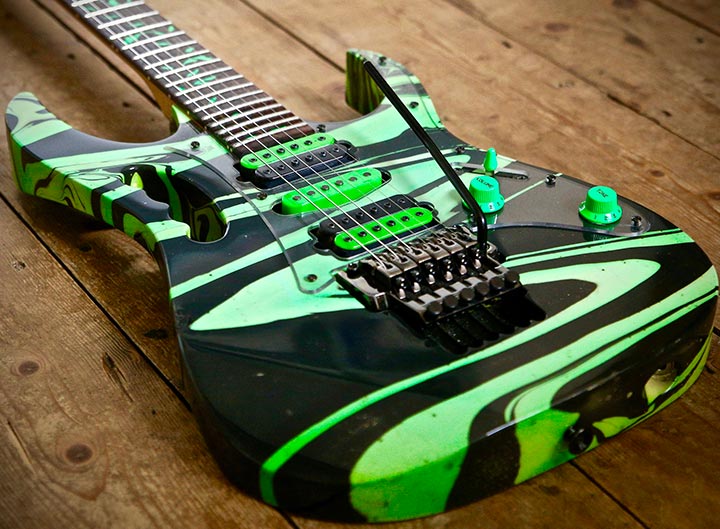
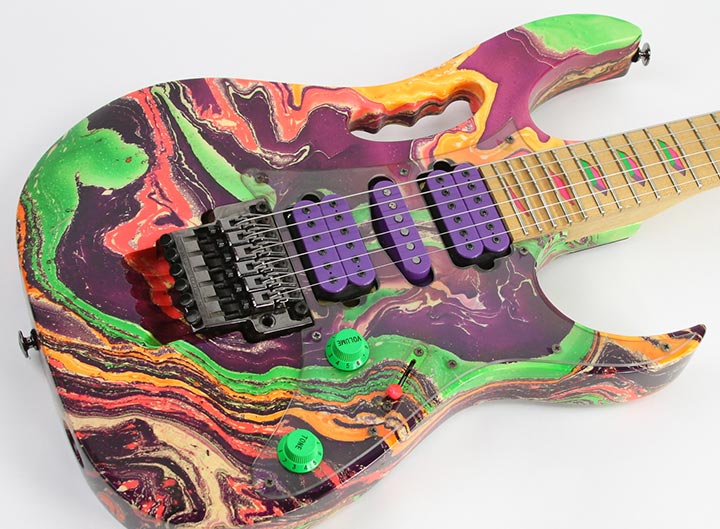
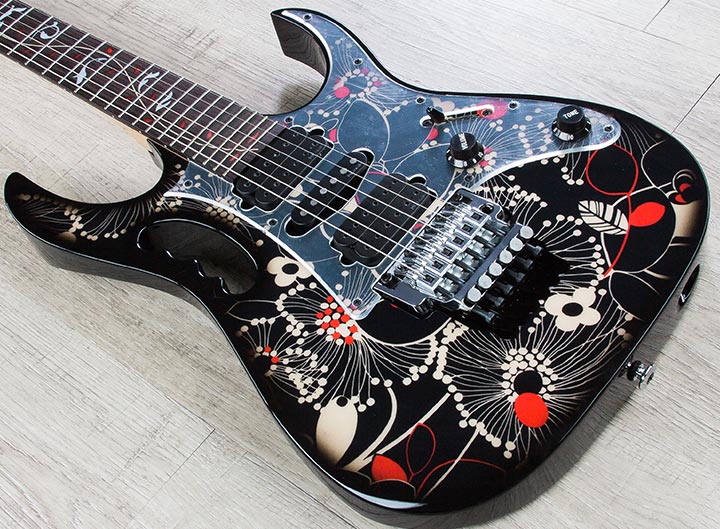
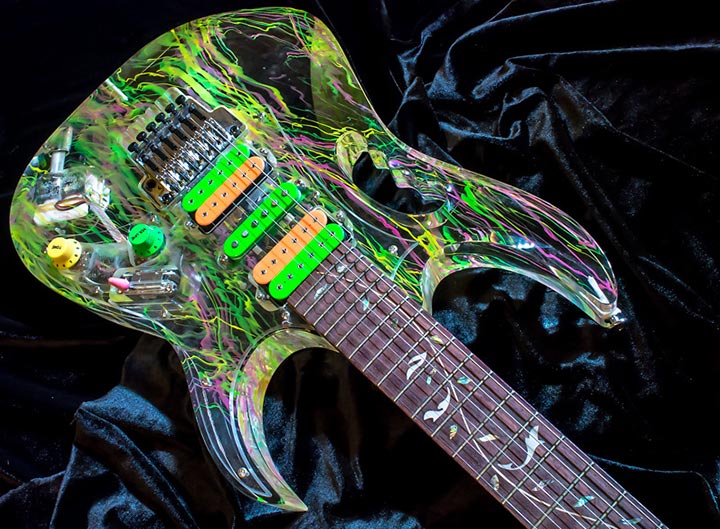
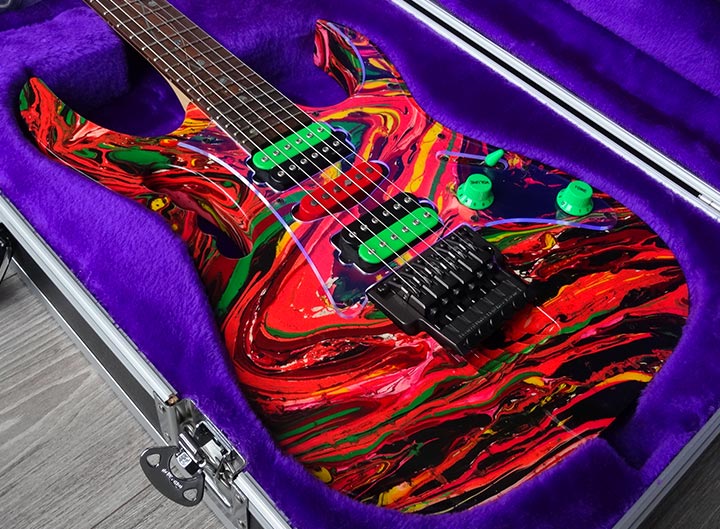
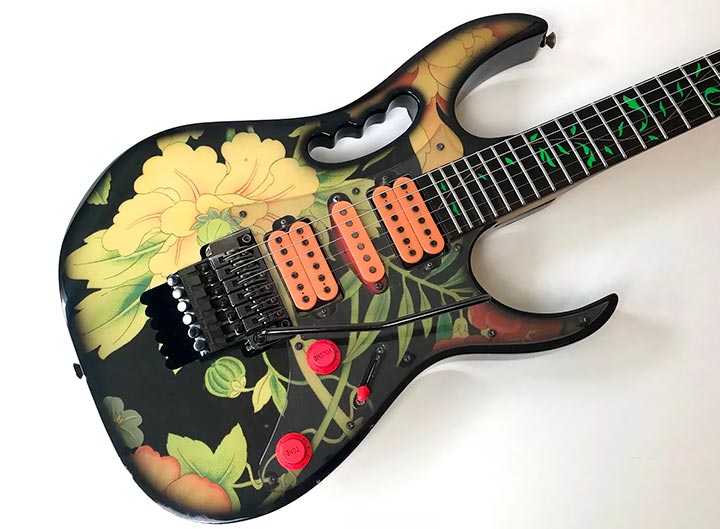
A small selection of high–end, limited edition JEM guitars
While we won't get into the specific pricing for all of the many JEM variants here, the most sought–after are the original '87 JEM777 models — several of which have sold for over $5,000 on Reverb. Other limited edition finishes from different eras have fetched similar prices.
Today, the standard issue JEM7V carries a new store price of $2,999, though it can often be found used for around $1,800. In the middle lies the JEM70V, which retails for $1,499. Ibanez has also built (and continues to build) many budget–friendly entries, like the JEM Jr, which typically sells for around $350 used.
For more on all things JEM, check out the very useful Ibanez Wiki which details most of the JEMs floating around the market.
Jackson Rhoads, Randy Rhoads Signature
Alongside the JEM, the Jackson Rhoads model ranks as another absolutely premier '80s artist guitar and was actually the first production guitar marketed by the nascent Jackson company.
This series went through a number of prototypes while Randy was still alive and working with Ozzy Osbourne. Similar to the SRV signature, the model would not make it into full–scale production until after Randy’s tragic passing.
The most distinctive features of the Rhoads centers on a neck–through design (though some models are bolt–on) and a sharper take on a V–style body shape, as seen earlier on Gibson's Flying V. The Rhoads sported a thinner neck, as well as a vintage Strat–style tremolo — unique for a V–style guitar at the time.
The original Rhoads models were some of the first production guitars to come stocked with Seymour Duncan pickups and — like the JEM — has spawned numerous versions in all price ranges.
At the top of the market, the 25th Anniversary Rhoads from 2005 sells today for over $4,000. There are a few even rarer Jackson Custom Shop one–offs that go for closer to $10,000.
The standard USA–made model in the current Jackson catalog — the Rhoads RR1 — typically sells between $1,000 and $1,500 used, while the entry–level JS32 can usually be found for less than $200.
Gibson Lucille, BB King Signature
We'll round out our review today with the Gibson Lucille, based on the most iconic Gibson ES guitars of all time. Introduced in 1980, the Lucille was designed and built to the exact specifications of BB King's various gigging guitars through the years.
The model is essentially a Gibson ES–355TD–CV with a maple neck and the F–holes removed in order to reduce feedback. The neck is like that of an early–'60s Gibson and will feel right at home with any fans of that particular Gibson vintage.
When coupled with stereo outputs, a six–way Varitone switch, and the TR–6 tailpiece found on several early '80s designs, the Lucille offers a set of specs unlike any other Gibson.
While most Lucilles sport the classic, sleek ebony finish preferred by BB, there are plenty of Cherry Red examples floating around, as well as some rarer finishes from Gibson's "gem" series.
Today, a brand new Gibson Memphis–built Lucille lists for $6,999. Typically, used Lucilles on Reverb sell in the $2,200 to $3,200, with some lucky buyers sniping deals at under $2,000.
There's also a budget version of the Lucille model produced by Epiphone, which can easily be found at the $500 mark.
